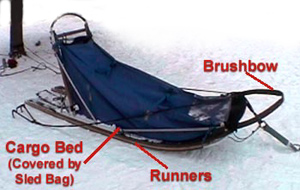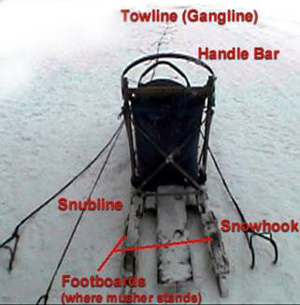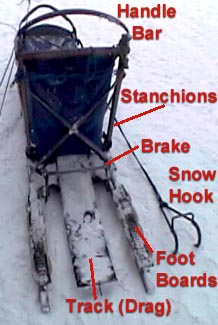The most common commands for a dog team are:
- Hike!: Get moving. To start a team or increase speed of a moving team.
- Gee!: Turn to the right.
- Haw!: Turn to the left.
- Easy!: Slow down.
- Straight Ahead!: move forward, for instance at an intersection of trails.
- Whoa!: Stop.
- On By!: Pass another team or other distraction.
- Line Out! Command to the Lead Dog to tighten the Gangline and pull the team out straight from the sled. Used while stopped to avoid tangles.
Other terms:
- Basket: the main body of a Sled, where passengers or gear may be carried.
- Bed or Cargo Bed: the floor of the Basket.
- Booties: slippers for dogs, worn while working under certain conditions to prevent ice forming between their toes. Made of a wide range of fabrics, including fleece and Gore-tex and usually held on by Velcro strips encircling the ankle.
- Brake: Metal claw or attached to the back of the Sled which when the Musher stands on it digs into the snow to stop or slow down the team. (see Drag)
- Bridle: a Harness made of poly rope that attaches to several points on a Sled so the pull of the dogs will not place undue stress on any one point of the Sled. The Gangline attaches to the Bridle often with an intermediate shock cord or bungee to reduce jarring the dogs.
- Brush Bow/Brush Bar: the curved piece out in front of the main body of a Sled, designed to stop brush from damaging the Sled and acts like a bumper on a car.

- Crabbing: when a dogs hindquarters pull at an outward angle instead of parallel to the Gangline. May be indicative of discomfort or fatigue.
- Distance Race: a multi-day dog sled race of 1000 miles, which usually involves wilderness camping, dealing with extreme weather, and rough trail conditions, such as the Iditarod or the Yukon Quest.
- Dog Bag: a fabric bag carried on a race sled, used to put a sick or injured dog into in order to carry him to a place where he can be cared for.
- Dog Barn: group housing for sled dogs. In Alaska, traditionally a structure where dogs stayed overnight while the mail carrier/musher slept in a roadhouse along the winter trail.
- Dog Box: a carrier for several dogs, most often seen as a wooden structure in the bed of a pickup truck. Styles vary widely, but usually built with individual sections that hold one or two dogs each.
- Dog Driver: the person who drives the sled dog team - also called a Musher.
- Dog Yard: place where the dogs live. Usually each dog has their own doghouse and they are tethered to a pole by a chain so they can run in a circle. Some dog yards are enclosed by a fence so the dogs can run free of a chain and socialize with other dogs.
- Drag, or Drag Mat: a rectangular piece of rubber, often made from an old Snowmachine track, attached to the back of the sled between the runners and used by the musher to control the speed of the team and sled by applying foot pressure.
- Driving Bow: the handle that the musher holds on to - also called a Handle Bow or a Handlebar.
- Foot Boards: place on the runners where the Musher stands, often covered with rubber or another non-slip treaded surface.
- Gee Pole: a four-foot pole that is attached to the front of the freight sled. The musher holds onto the Gee Pole, and walks on snowshoes or rides on a Ouija Board or skis, between the sled and the dogs, to control the direction of the sled when it’s carrying a heavy load.
- Gangline: connects the pulling dogs to the sled. Consists of one or more rope sections that runs down the middle of the dog team, upon which Tuglines and Necklines attached. The gangline attaches to the Sled at the Bridle.
- Handler: a person who assists the musher, usually during a race or in the dog yard.
- Handle Bow or Handlebar: the handle a musher holds on to - also called a Driving Bow.

- Harness: a webbing of fabric, usually nylon and fleece (but historically was hide and fur), that snugly fits around a dog’s body, to which the Tugline is attached.
- Lead Dogs: the dog or dogs in the front of a team, who understand and take the Musher voice commands. Leaders are noted for their high level of intelligence, drive and trail savvy. Commonly run as Single lead (1 dog) or Double lead (2 dogs).
- Loose Leader: a lead dog who runs free of the team, yet still guides the tethered team and listens to commands.
- Mid-distance Race: a multi-day dog sled race of 200 to 300 miles, which usually involves wilderness camping, dealing with extreme weather, and rough trail conditions, such as the Gin Gin 200, Copper Basin 300, Yukon Quest 300.
- Musher: a person who drives, cares for and manages a sled dog team - also called a Dog Driver.
- Neckline: a short line (10-12 inches) attached loosely between the dog collar and Gangline, or between the collars of double leaders, that keeps the dogs in line.
- Ouija Boards: a small board that the Musher would stand on instead of skis or snowshoes when using a Gee Pole to steer a heavily loaded dog sled. The Ouija board floats on top of the snow, like a modern snow board, so the musher can keep up with the running dog team instead of having to run when using snowshoes.
- Overflow: water flowing on top of an already frozen surface which is a potential hazard when encountered on the trail.
- Pedaling: pushing or kicking the ground with one foot while keeping the other on the sled to help provide extra momentum for the dog team.
- Point Dogs: used by some mushers to denote the two dogs right behind the Lead Dogs. Others call them, Swing Dogs.
- Rigging: all the lines used to attach dogs to a sled (gangline, tuglines and necklines).
- Rookie: A musher who is running a race for the first time or who has never completed the race.
- Rough Locks: are chains which are put on the Runners on steep downhills to slow the sled down. They are usually wrapped around the runners to create drag.
- Runners: The two bottom pieces of the sled which come in contact with the snow. Runner bottoms are usually wood, covered with a replaceable plastic or Teflon layer (historically it was bone, antler, ivory and later metal) used to decrease friction and reduce maintenance. This plastic covering or Teflon layer is usually replaced at least once during a long race. The runners extend behind the Basket, so the Musher can stand on them (the Foot Boards).
- Safety Line: an extra line that runs from the Gangline to the sled, in case the main line breaks.
- Side Rails: the side pieces of a sled that run along the outside to support the bed, usually a few inches above the runners.
- Slats: thin strips of wood that make up the bottom of a wooden sled basket. Toboggan sleds have a sheet of plastic as the bottom of their basket.
- Sled Bag: bag that sits on the bed of the sled and can be used to store items that ride in the basket to contain them.

- Sprint Race: a fast, shorter distance single-day race, or a multi-day event with different short distances covered each day totaled together for a final race time, such as the North American Sled Dog Races in Fairbanks, the Fur Rendezvous Races in Anchorage, and village winter carnival races.
- Snow Hook: a large metal hook that is attached to the Gangline and is driven into firm snow to anchor a team for a short period of time without needing to tie them to something.
- Snowmachine: Alaskan term for “snowmobile.” Sometimes used by mushers for packing and grooming trails.
- Snub Line: a rope attached to the Gangline or Bridle, which can be tied to a tree to hold the team when the snow is not firm enough to use a Snow Hook.
- Stake: metal or wooden post driven into the ground used to tie up a dog.
- Stakeout: a main chain with separate short chains to attach several dogs to. May be strung between the front and back bumpers of a truck, or between two trees.
- Stanchions: the upright pieces that attach the Runners to a sled body/basket.
- Swing Dogs: depending on which musher you're talking to, either the two dogs directly behind the Lead Dogs, or those between the Point Dogs and the Wheel Dogs.
- Team Dogs: all dogs other than the Lead Dogs, Point Dogs, Swing Dogs and Wheel Dogs.
- Tether Line: a long chain with smaller pieces extending from it used to Stake out a team when no stakes are available.
- Toboggan: a sled with a flat bottom instead of having separate Runners. Used when deep, soft snow is expected instead of a good trail.
- Tuglines: the line that connects the back end of the harness to the Gangline - the line that the individual dog tugs on.
- Wheel Dogs: the dog or pair of dogs harnessed closest to the Sled. They are generally stronger and often larger than their teammates and must take the greatest load when making turns or changing directions.

